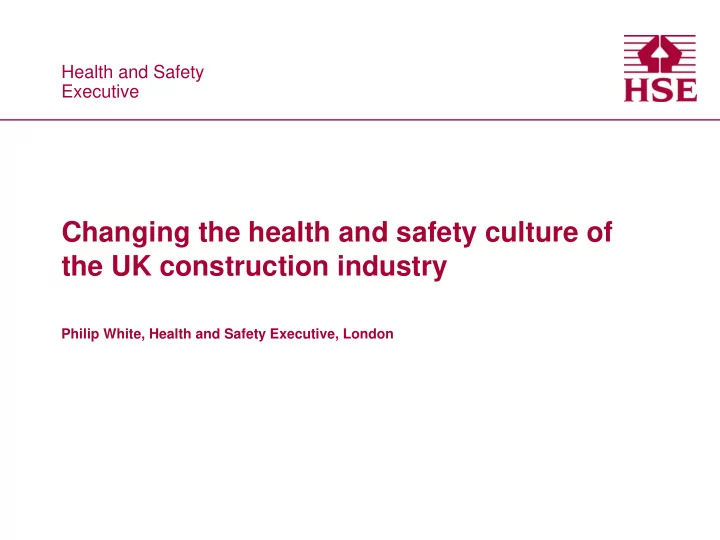

Health and Safety Health and Safety Executive Executive Changing the health and safety culture of the UK construction industry Philip White, Health and Safety Executive, London
Fatal Accidents – numbers and rates Fatal Injuries to Workers in Construction January 1981 to March 2010 10 9 rs 200 e 8 rk rs o e w rk 7 0 o 0 W ,0 150 0 to 6 0 r 1 s rie e p 5 ju te l In t ra 100 4 ta n a e f F id 3 . o c c o l A N 50 2 ta a F 1 0 0 1 1 1 1 1 1 1 1 1 1 1 1 1 1 1 1 1 1 1 2 2 2 2 2 2 2 2 2 2 9 9 9 9 9 9 9 9 0 0 0 0 9 9 9 9 9 9 9 9 9 9 9 0 0 0 0 0 0 8 8 8 8 8 8 8 8 8 9 9 9 9 9 9 9 9 9 9 0 0 0 0 0 0 0 0 0 0 1 2 3 4 5 6 7 8 9 0 1 2 3 4 5 6 7 8 9 0 1 2 3 4 5 6 7 8 9 / / / / / / / / / / / / / / / / / / / / / / / / 8 8 8 9 9 9 9 9 9 9 9 9 9 0 0 0 0 0 0 0 0 0 0 1 7 8 9 0 1 2 3 4 5 6 7 8 9 0 1 2 3 4 5 6 7 8 9 0 p
Construction Programme • 10 year programme • Aim to reduce fatal accidents, major injuries and ill health • Cultural change – leadership, ownership and partnership • Engrain a culture of ‘self-regulation’ • Embed improvements made • Evidence based • Development of Influence Network
The Influence Network Social, Political and Market Context Corporate Policy Influences Organisation & Management Systems Human and Technical Systems 4
The Influence Network SAFETY IN CONSTRUCTION Human Hardware External Quality Availability Availability Quality of Internal Operating Motivation Team Situational Equipment Competence Fatigue Health of of Info/ Compliance of Suitable Inspection & Working Conditions /Morale Working Awareness Operability Comms Advice Resources Maintenance Environment Direct Level Influences Information Inspection & Design for Recruitment Management/ Safety Equipment Training Procedures Planning Management Comms Maintenance safe & Selection Supervision Culture Purchasing & Feedback Policy construction Organisational Level Influences Contracting Ownership Company Labour Company Organisational Safety Strategy and Control Culture Relations Profitability Structure Management Policy Level Influences Political Influence Regulatory Influence Market Influence Social Influence Environmental Level 5 Influences
Construction Programme Revamped Intervention Strategy: • Not just site inspection • Intervene earlier in the process – with clients and designers • Engage senior management – at Board level • Addressing underlying causation – in investigations and inspections • Engage and help small firms • Include the Government leading by example – client interventions • Supply chain work • Managing health risks – priority topics • Engaging the workforce – through site interventions, toolkits and encourage industry developments
Leadership • Leadership from senior industry figures • Industry ownership of risk • ‘Turning concern into action’ • Putting health and safety on the Board agenda • Seeing health and safety as an enabler
Supply chain work • Re–engineering processes • Work with industry stakeholders • Making use of technological advances • Tackled: � industrial roofing – use of nets � demolition – remote techniques � steel erection – remote techniques � cement bags – lower weight � cutting paving slabs and kerbs – water suppression
Example of supply chain change – Demolition Before After
Example of supply chain change – After Kerb cutting Before
Small/medium sized projects • Small Sites Strategy – roofwork, asbestos, dust, site tidiness and welfare provision • Targeted campaigns – eg. National refurbishment initiative, improving dutyholder compliance and many local initiatives • Communication and education through: – Working Well Together – website – guidance
SMEs
Progress Fatal Accidents • 2000/01 – 105, a rate 5.9 per 100,00 workers • 2010/11 – 50, a rate of 2.4 per 100,000 workers Major injuries • 2000/01 - 4,303 and the equivalent rate 380.9 per 100,000 employees • 2009/10p - 2,585 major injuries and a rate of 230.0
Progress 50.0 30.0 10.0 % fatal rate change (Workers) % Rate Change % MI (Employees) rate change -10.0 % RHS Target -30.0 -50.0 -70.0 99/00 00/01 01/02 02/03 03/04 04/05 05/06 06/07 07/08 08/09 09/10 10/11p Year
Progress But: • Are the changes in culture sustainable? • Impact of the economic downturn • Perennial challenge of those outside the ‘organised’ industry • Health issues
Keys to success • Understanding the industry and its mechanisms • Securing leadership by risk creators • Leadership from within the industry • Clarity of purpose • Outcome led approach • Leverage by influencing at the right time and at the right level • Traction through the supply chain • Working together in partnership • Inspection core to delivery but targeted • Broad range of interventions
Recommend
More recommend